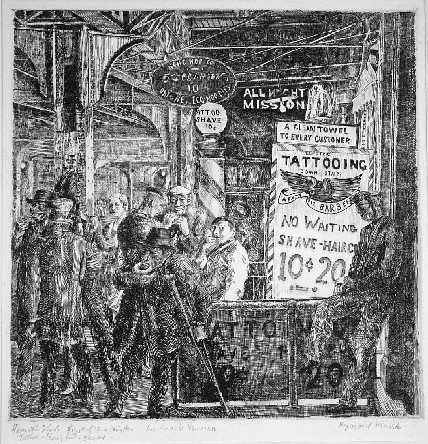Tatoo-Shave-Haircut
Reginald Marsh (1898-1954), Tattoo-Shave-Haircut, etching, 1932. Signed, titled (Tattoo-Haircut-Shave), dedicated (for Arnold Newman), and annotated (Fourth State. First of Two Prints). Reference: Sasowsky 140. On cream wove paper. In very good condition, with small margins (as trimmed, slightly irregularly, by the artist) (slight foxing in margins), remains of prior hinging verso; 9 7/8 x 9 3/4, the sheet 10 15/16 x 10 5/8 inches; archival matting.
A very fine rich black impression.
Provenance: Estate of Arnold Newman. Arnold Newman (1918-2006) was one of the great 20th Century masters of photography, and a friend of many leading artists; it is appears that Marsh took special care in printing this impression for Newman.
Sasowsky calls for 10 states of Tattoo-Shave, based largely on Marsh’s notes. But the states are not clearly delineated (e.g., his States 3 and 4, one proof each, are characterized by Marsh as Engraving added; no information is given for State 5). The design for the print was complete in the first state, and subsequent state changes were not, apparently, major.
This impression does not appear to differ in etching lines from the final state impression shown in Sasowsky. Its inscription (as a Fourth State, by Marsh), as well as its rich inking and quality, attest to its being a proof before the edition (of about 34 impressions), but the state of this print (and, presumably of many of the other several proof impressions) cannot at this time be stated with confidence.
Marsh printed this impression personally (we recall his famous answer to a question about the size of his editions: Since I do practically all my own printing, I do not limit the edition. The buyer limits the edition he rarely buys, I rarely print).
Tattoo-Shave-Haircut depicts a scene in the Bowery, a section of New Yorks Lower East Side, during the Great Depression. The building and train structures in the top half of the print recall Piranesis Carceri the imaginary prisons; the bottom half portrays some of the denizons of the neighborhood. The print famously captured the spirit of the city, and the country, during this difficult period.
